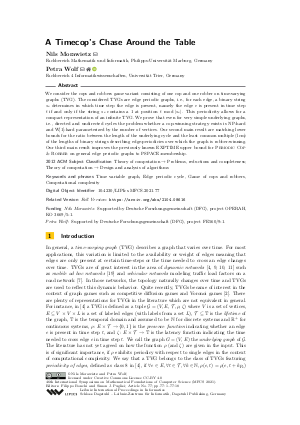A Timecop’s Chase Around the Table
Authors
Nils Morawietz,
Petra Wolf 
-
Part of:
Volume:
46th International Symposium on Mathematical Foundations of Computer Science (MFCS 2021)
Part of: Series: Leibniz International Proceedings in Informatics (LIPIcs)
Part of: Conference: Mathematical Foundations of Computer Science (MFCS) - License:
 Creative Commons Attribution 4.0 International license
Creative Commons Attribution 4.0 International license
- Publication Date: 2021-08-18
File

PDF
LIPIcs.MFCS.2021.77.pdf
- Filesize: 0.78 MB
- 18 pages
Document Identifiers
Related Versions
- Full Version https://arxiv.org/abs/2104.08616
Subject Classification
ACM Subject Classification
- Theory of computation → Problems, reductions and completeness
- Theory of computation → Design and analysis of algorithms
Keywords
- Time variable graph
- Edge periodic cycle
- Game of cops and robbers
- Computational complexity
Metrics
- Access Statistics
-
Total Accesses (updated on a weekly basis)
0Document
0Metadata
Abstract
We consider the cops and robbers game variant consisting of one cop and one robber on time-varying graphs (TVG). The considered TVGs are edge periodic graphs, i.e., for each edge, a binary string s_e determines in which time step the edge is present, namely the edge e is present in time step t if and only if the string s_e contains a 1 at position t mod |s_e|. This periodicity allows for a compact representation of an infinite TVG. We prove that even for very simple underlying graphs, i.e., directed and undirected cycles the problem whether a cop-winning strategy exists is NP-hard and W[1]-hard parameterized by the number of vertices. Our second main result are matching lower bounds for the ratio between the length of the underlying cycle and the least common multiple (lcm) of the lengths of binary strings describing edge-periodicies over which the graph is robber-winning. Our third main result improves the previously known EXPTIME upper bound for Periodic Cop & Robber on general edge periodic graphs to PSPACE-membership.
Cite As Get BibTex
Nils Morawietz and Petra Wolf. A Timecop’s Chase Around the Table. In 46th International Symposium on Mathematical Foundations of Computer Science (MFCS 2021). Leibniz International Proceedings in Informatics (LIPIcs), Volume 202, pp. 77:1-77:18, Schloss Dagstuhl – Leibniz-Zentrum für Informatik (2021)
https://doi.org/10.4230/LIPIcs.MFCS.2021.77
BibTex
@InProceedings{morawietz_et_al:LIPIcs.MFCS.2021.77,
author = {Morawietz, Nils and Wolf, Petra},
title = {{A Timecop’s Chase Around the Table}},
booktitle = {46th International Symposium on Mathematical Foundations of Computer Science (MFCS 2021)},
pages = {77:1--77:18},
series = {Leibniz International Proceedings in Informatics (LIPIcs)},
ISBN = {978-3-95977-201-3},
ISSN = {1868-8969},
year = {2021},
volume = {202},
editor = {Bonchi, Filippo and Puglisi, Simon J.},
publisher = {Schloss Dagstuhl -- Leibniz-Zentrum f{\"u}r Informatik},
address = {Dagstuhl, Germany},
URL = {https://drops.dagstuhl.de/entities/document/10.4230/LIPIcs.MFCS.2021.77},
URN = {urn:nbn:de:0030-drops-145176},
doi = {10.4230/LIPIcs.MFCS.2021.77},
annote = {Keywords: Time variable graph, Edge periodic cycle, Game of cops and robbers, Computational complexity}
}
Author Details
Funding
- Morawietz, Nils: {Supported by Deutsche Forschungsgemeinschaft (DFG), project OPERAH, KO 3669/5-1.}
- Wolf, Petra: Supported by Deutsche Forschungsgemeinschaft (DFG), project FE560/9-1.
References
-
Sandeep Bhadra and Afonso Ferreira. Complexity of connected components in evolving graphs and the computation of multicast trees in dynamic networks. In Proceedings of the 2nd International Conference on Ad-Hoc, Mobile, and Wireless Networks, volume 2865 of Lecture Notes in Computer Science, pages 259-270. Springer, 2003.

- Niclas Boehmer, Vincent Froese, Julia Henkel, Yvonne Lasars, Rolf Niedermeier, and Malte Renken. Two influence maximization games on graphs made temporal. CoRR, abs/2105.05987, 2021. URL: http://arxiv.org/abs/2105.05987.
-
Anthony Bonato. The game of cops and robbers on graphs. American Mathematical Soc., 2011.

-
Arnaud Casteigts, Paola Flocchini, Walter Quattrociocchi, and Nicola Santoro. Time-varying graphs and dynamic networks. Int. J. Parallel Emergent Distributed Syst., 27(5):387-408, 2012.

-
Nancy E. Clarke and Gary MacGillivray. Characterizations of k-copwin graphs. Discret. Math., 312(8):1421-1425, 2012.

-
Luca de Alfaro, Thomas A. Henzinger, and Orna Kupferman. Concurrent reachability games. Theor. Comput. Sci., 386(3):188-217, 2007.

-
Bolin Ding, Jeffrey Xu Yu, and Lu Qin. Finding time-dependent shortest paths over large graphs. In Proceedings of the 11th International Conference on Extending Database Technology, volume 261 of ACM International Conference Proceeding Series, pages 205-216. ACM, 2008.

-
Thomas Erlebach and Jakob T. Spooner. A game of cops and robbers on graphs with periodic edge-connectivity. In Proceedings of 46th International Conference on Current Trends in Theory and Practice of Informatics, volume 12011 of Lecture Notes in Computer Science, pages 64-75. Springer, 2020.

-
Niloy Ganguly, Andreas Deutsch, and Animesh Mukherjee. Dynamics on and of complex networks. Applications to Biology, Computer Science, and the Social Sciences, 2009.

-
Petter Holme. Modern temporal network theory: a colloquium. The European Physical Journal B, 88(9):1-30, 2015.

-
Petter Holme and Jari Saramäki. Temporal networks. Physics reports, 519(3):97-125, 2012.

-
Neil Immerman. Number of quantifiers is better than number of tape cells. J. Comput. Syst. Sci., 22(3):384-406, 1981.

-
Othon Michail and Paul G. Spirakis. Traveling salesman problems in temporal graphs. Theor. Comput. Sci., 634:1-23, 2016.

-
Nils Morawietz, Carolin Rehs, and Mathias Weller. A timecop’s work is harder than you think. In Proceedings of the 45th International Symposium on Mathematical Foundations of Computer Science, volume 170 of LIPIcs, pages 71:1-71:14. Schloss Dagstuhl - Leibniz-Zentrum für Informatik, 2020.

-
Richard J. Nowakowski and Peter Winkler. Vertex-to-vertex pursuit in a graph. Discret. Math., 43(2-3):235-239, 1983.

-
Alain Quilliot. Jeux et pointes fixes sur les graphes. PhD thesis, Ph. D. Dissertation, Université de Paris VI, 1978.

-
Klaus Sutner and Wolfgang Maass. Motion planning among time dependent obstacles. Acta Informatica, 26(1-2):93-122, 1988.

-
Klaus Wehmuth, Artur Ziviani, and Eric Fleury. A unifying model for representing time-varying graphs. In 2015 IEEE International Conference on Data Science and Advanced Analytics, DSAA 2015, Campus des Cordeliers, Paris, France, October 19-21, 2015, pages 1-10. IEEE, 2015.

-
Zhensheng Zhang. Routing in intermittently connected mobile ad hoc networks and delay tolerant networks: Overview and challenges. IEEE Commun. Surv. Tutorials, 8(1-4):24-37, 2006.

